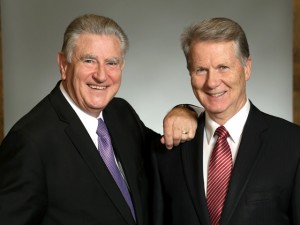In our first-ever edition of riskinfo Magazine in late 2010, we profiled risk-focussed dealer group, Synchron. Five years later, we’ve revisited Synchron. We talked to its Directors Don Trapnell and John Prossor about their progress since our original article and their outlook for the future of financial advice, in what continues to be a critical and formative time for the sector…
To an extent, the Synchron journey over the last five years mirrors that of many dealer groups, all of whom have experienced the regulatory trials and tribulations associated with the Future of Financial Advice reforms, ASIC’s Review of Retail Life Insurance Advice, the controversial Trowbridge reform model proposals and more lately the new Life Insurance Framework reforms.
It’s been far from plain sailing for Synchron because of these regulatory challenges as well as other issues it’s had to confront.
But through all these issues Synchron has maintained its outspoken advocacy in defending the role of the financial adviser, while still finding time to consolidate and grow its business footprint across the country.
What’s important to you?
Lamenting the disappearance of soft skills training for new entrants into the advice sector, Don Trapnell said “…the industry has bred an entire generation of advisers, both financial advisers and risk advisers who somehow believe it’s appropriate to bludgeon a client into submission with facts and figures because they haven’t been taught those soft skills.”
Trapnell continued, “People are important. We’re in a people business, and that’s what sales skills are. Sales skills are not the slick salesman with the gold tooth. Sales skills are using people skills to communicate and not put barriers in the way of a consumer to prevent them from making a decision. As far as Synchron’s concerned, the people business is important to us.
The Synchron ‘identity’
About two years ago, Trapnell and fellow Director, John Prossor, invited three life company executives to a retreat to ask them what they would have to do in order to become one of the top ten licensees in Australia. “At that stage, were about number 15 or 16 by adviser count,” said Trapnell.
“They all said you’ve got to be more corporatised if you’re going to be in the top ten space – that you have to have more of a corporate approach to the world.”
Trapnell and Prossor reflected that what has got their business to where it was two years ago was the very fact that it was not corporatised or embraced a corporate culture. “The thing that saw us become one of the fastest growing licensees in Australia was the fact that we do run it like a family,” said Trapnell. “For example, there are no road blocks between John Prossor’s office and any adviser in our network.” Saying the same applies to his own office, Trapnell emphasised the importance of approachability as part of the family culture the licensee has developed and nurtured. Like many such organisations, this culture of family and approachability also reflects the personality of both Trapnell and Prossor.
“So we rejected the idea of becoming corporatised,” said Trapnell.
Trapnell and Prossor conducted a similar meeting earlier this year. This time, none of the three industry peers they invited suggested Synchron consider the corporate route. All three urged the Directors not to lose sight of what has brought them the success they have experienced.
The Synchron family is our greatest strength
Business and adviser growth
And success is what Synchron has achieved, by any measure, whether it relates to adviser numbers or revenue.
The non-aligned business is currently eyeing off the goal of becoming the third-highest producer of risk new business in Australia (where AMP and Charter are the clear leaders in this measure). “We’re number six in Australia right now for risk new business,” says Trapnell. But he and Prossor are developing strategies which, if achieved, will deliver the number three position to Synchron.
Trapnell also noted industry data that reports Synchron was one of only two risk-focussed licensee groups that experienced positive new business growth in the year to June.
In terms of adviser numbers, the licensee boasts 372 authorised representatives as at September 2015, which places the firm at number 13 in the country by that measure. Its growth in adviser numbers over the last ten years reflects a tale of success:
| Year | Number of advisers | Ranking |
|---|---|---|
| 2005 | 93 | 40 |
| 2010 | 162 | 25 |
| 2015 | 372 | 13 |
It’s not just about how many advisers now operate under the Synchron banner, but who they are. In 2010, one third of the dealer’s 162 advisers were aged under 40, which reflected a significant change in its strategy, which had commenced in 2005, with the implementation of its youth policy.
The firm’s youth policy is centred on its unique Next Gen program. The Directors told us they are proud of what they have achieved, and point out no other licensee conducts a similar program. “No-one else has it,” says Trapnell.
The Next Gen program, which includes an annual conference, attended by both Next Gen Synchron advisers and other industry contributors, has been instrumental in contributing to lowering the average age of Synchron advisers. Their average age in 2010 was 55, compared with the industry average at the time of 58. In 2015, the average Synchron adviser age has reduced to 49, while Trapnell says the industry’s average adviser age remains at 58.
I can’t think of one adviser who has left the industry because they felt the FoFA reforms were too hard.
While declaring the Next Gen program is succeeding in attracting young advisers, Trapnell stresses that “…we’re not doing it by moving on mature age advisers, who maintain a wealth of knowledge for all our advisers. We’re doing it by bringing on young advisers.”
Life Insurance Framework
Trapnell and Synchron have been outspoken advocates in representing the case, on behalf of its adviser force, for a fair and reasonable outcome in the debate on the Life Insurance Framework provisions. “Any business model that requires you to have negative revenue for a period of time is not a good business model. It’s a very bad business model,” says Trapnell.
He and Prossor say they have ‘done the maths’ on what the new provisions would mean (before the announcement that clawbacks were to reduce from three to two years). “We would like to think that 60/20 will not happen, but we definitely would like to think the three year responsibility period would not happen,” said Trapnell. “A two year responsibility period the industry could probably live with. But three year responsibility is purely unfair – both the period of time and the circumstances under which a clawback occurs.”
LIF and lapses
Trapnell and Prossor are frustrated at the lack of consistency surrounding the definition of a lapsed policy.
“How do you calculate a lapse?” asks Trapnell, “…because every insurance company has a different way of calculating them. Is a death claim a lapse? Is a client rejecting an automatic increase a lapse? For two insurance companies it is. It’s classed as a lapse.
The Directors agreed this lack of clarity is frustrating for all licensees and offered a ‘back to the future’ suggestion: They said that in the 70s and 80s there was a consistent definition used by the whole industry, where the formula for lapses at an individual adviser level related to their last two years production divided by the last 12 months’ discontinuances.
“That was how you calculated the lapse rate,” said Trapnell. “So any policy that was more than two years old didn’t get counted in the production numbers and therefore lapse rate calcs. It was across the industry and every company used it.”
“People should have tenure over their income,” continued Trapnell. “It’s a basic right. If you do your job and you’re paid for doing your job you should have tenure over that. And it’s wrong that someone else can take that away from you. It is anti-business and it is anti the individual.”
What works for Synchron?
Synchron has crunched the numbers (assuming the three-year clawback) on what happens if LIF comes into effect in its current form:
“If we achieve a certain number of advisers under our license we know that, revenue wise, we’ll be exactly the same. The level of 20% renewal commissions will eventually offset the reduction in upfront commissions,” said Trapnell, who concluded, with Prossor, that an adviser would have to write one extra case every two months for the LIF provisions to have no detrimental effect on his or her revenue. “One extra case every two months does not represent a detrimental change in cashflow,” they concluded.
This is an important factor and highlights to an extent the dealer’s pragmatic approach to the implementation of the Life Insurance Framework reforms. “That does not mean we support the 60/20 hybrid remuneration model,” noted Trapnell. “But what it does mean is that the world is not going to come to an end if that’s what eventually happens.”
Business efficiencies
In 2010, we reported Synchron’s optimum target number of authorised representatives was 280. This target number, which it exceeded last year, was based on current staffing levels and technology capabilities. Asked what has changed to allow this additional growth, Prossor said “Both of those!” That is, staffing numbers and technology have allowed further growth.
by allowing that lead in period, the financial impact isn’t as bad as what people believe it to be
“We invest very heavily in technology in this firm. We are the only licensee that not only can, but does, pay commissions daily,” added Trapnell. “I don’t think any other licensee would be able or prepared to do it unless they invested in the staffing required for such an undertaking and the investment in the software needed to achieve this process and outcome.”
Trapnell and Prossor also talked about their current engagement of a firm of software manufacturers to develop some analytical software for its advisers in relation to their remuneration operations, as well as for opt in process requirements, fee disclosure statements and other operational needs.
Prossor said the original target of 280 authorised representatives was, on reflection, “… a ridiculously high figure and we couldn’t imagine getting there.” However, that target has been achieved and surpassed. And while the licensee has added more staff to serve the growing firm, the additional staff growth, from 20 in 2010 to 24 in 2015 appears to be relatively modest when compared with the more than doubling of its adviser force in the same period. “We’ve reached a critical mass,” says Prossor.
Projections for the next two years, if achieved, will place Synchron within the top ten licensees in Australia in terms of adviser numbers and number three in terms of risk new business.
Efficiencies also extend to the quality of the business written by Synchron advisers, where Prossor noted the licensee was ‘punching above its weight’ in terms of the proportion of adviser numbers and total revenue. He says he puts this down to “…the selection of good quality advisers, good compliance and a very strong filtering system for advisers joining Synchron. We reject as many as we accept,” he noted.
Paul Riegelhuth
The tragic death in 2013 of Synchron’s highly-respected third Director, Paul Riegelhuth, was a body blow to the business and to all who knew him.
“Synchron is a different business today, because of Paul’s death,” said Trapnell. “Were Paul alive today, yes, Synchron would be slightly different to what it is now. Paul’s death did force us to reinvent ourselves to a certain extent.”
One of the needs Synchron identified after Riegelhuth’s death was its need for a Victorian state manager – a position it filled recently, with the appointment of Jason Milosevski.
What makes Synchron different?
In 2010, Synchron highlighted three factors that it said differentiated it from its competitors: they pay commission daily, each Director was a practising adviser and it allowed an open APL for risk products and most investment platforms.
Synchron remains the only licensee to pay revenues daily. Asked why this was the case, Prossor said the daily process is challenging to administer and to maintain effectively and efficiently. He added a second reason may relate to the ability for other licensees to have access to that money and invest it in the short-term to earn a margin before distributing.
The Directors continue to retain and advise their own client base and become the guinea pigs for any new technology or process before rolling it to the rest of their advisers, thereby appreciating exactly what these changes will mean to their advisers and their businesses.
The dealer’s Next Gen program is a clear differentiator for it, as is its intentional non-corporate, ‘family’ business culture.
“And we try to do things differently,” said Trapnell. “We said that last time (five years ago) and we’re saying it now.”
By way of example, Trapnell related said he was recently told by an executive at a life company, ‘You’re a bit weird, Don.’ “And I loved that!” he said. “And I said ‘thank you.’ He said ‘you’re a little bit weird and you do things that other people don’t.”
Prossor re-emphasised “…it’s a relationship business and that’s why we’re not going corporate. The Synchron family is our greatest strength.”
The future
Looking first at the past, both Trapnell and Prossor admitted their mistake when they predicted the Future of Financial Advice reforms would no doubt end the careers of many advisers, who would not be able to cope with the transition to fee for advice.
“We were wrong in one regard, said Trapnell. “Five years ago we did anticipate some advisers leaving the industry. That hasn’t happened – not beyond natural attrition,” he said, continuing, “I can’t think of one adviser who has left the industry because they felt the FoFA reforms were too hard.” Trapnell and Prossor attribute that outcome to a very long lead-in time.
They also agree the three-year lead-in period for the Life Insurance Framework reforms is absolutely critical to the whole process. “If LIF happened tomorrow, it would be disastrous for some practices. If you actually do the maths, by allowing that lead in period, the financial impact isn’t as bad as what people believe it to be,” said Trapnell.
Prossor added, “… we’ve done the numbers and it’s a temporary aberration for the longer-term adviser. Depending on who you talk to there’s a break-even point at year three or year two-and-a-half, depending on what assumptions you make.”
He said he doesn’t believe the LIF changes will have as big an effect on advisers in future as the overall raising of the educational qualifications bar. “I don’t know what it will be, but I think it will be the last straw for some of the advisers who may be nearing retirement age. So it could bring forward a little the retirement of some advisers,” he said.
Looking to the future, Prossor noted Synchron is now recruiting more holistic-aligned advisers. He makes the distinction that Synchron is known as a risk-focussed business, but is not a risk-only licensee. Evidence of the trend to recruiting holistic advisers to the firm can be seen in Synchron’s revenue splits. In 2010, Prossor noted business revenue comprised 80% from risk advice and 20% from investment, superannuation and retirement income advice streams. In 2015, Prossor says those proportions have narrowed, where 70% of revenue comes from risk advice, while 30% now comes from investment and superannuation advice revenue. So, while the licensee continues to be risk-focussed, it has increased its non-risk revenue by 50% in the last five years, from 20% to 30%.
As its story continues to unfold, five years after our original profile of this passionate risk-focused ‘family’, riskinfo can report that Synchron continues to do things differently, and that Don Trapnell continues to remain a little bit weird.










